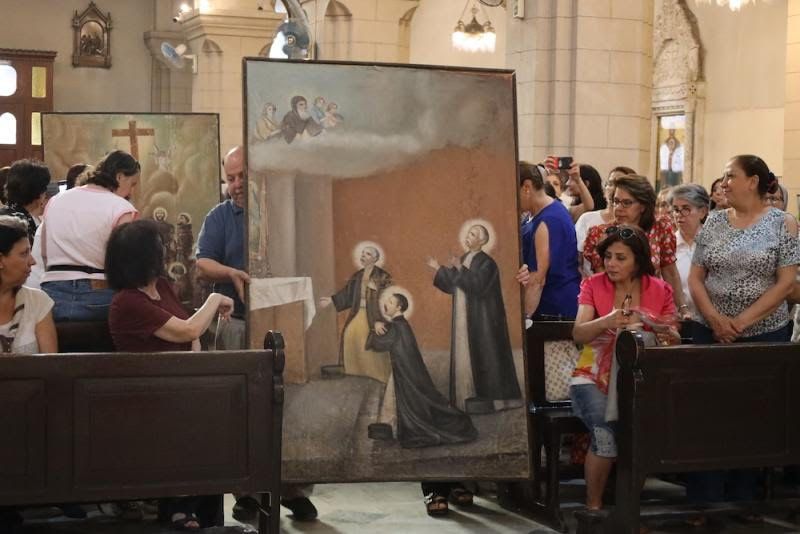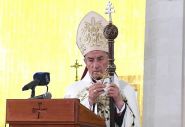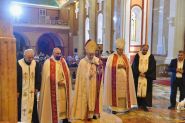
Today, October 20, the universal Church has been graced with the addition of 14 new figures of holiness, including eleven martyrs: eight Franciscan religious and three Maronite laymen, the brothers Francis, Abdel Mohti, and Raphael Massabki.
All were brutally killed in Damascus during the night of July 9 to 10, 1860, for their refusal to renounce their Christian faith.
The canonization mass, presided over by Pope Francis, took place in St. Peter's Square. Maronite Patriarch Bechara al-Rai also participated in the mass. However, due to the circumstances the country is facing, a relatively small number of Lebanese attended the ceremony on-site.
The context surrounding what has been termed the "Massacres of Damascus" is complex and rich in insights. “Due to socio-economic changes,” writes historian Henry Laurens, a professor at the Collège de France, “Christian populations grew significantly during the 19th century (...). Moreover, through missionary outreach, they gained better access to modern education and, therefore, were better positioned in the job market (editor's note: emphasis added).
Finally, under pressure from Western public opinion, they became a marker of modernity: treating non-Muslim communities well demonstrates a civilized political relationship with the population (...). The conflicts between Druze and Christians thus unfolded within a confessional interpretation of the region. The massacres of 1860 were the result of the relative frustration of local Muslim groups toward those perceived as benefiting from reforms, recent shifts in power dynamics, and the intervention of external stakeholders.” (*)
Academic Language and Reality
This academic language should not cover up a daily reality characterized by deep-seated confessional animosities exacerbated by Ottoman governors, European colonial powers, and their economic agendas, along with a rising awareness that was hostile to the feudal structures of the time.
The outbreak of confessional violence initially began in Mount Lebanon before extending to Zahleh and Damascus.
The Massabki family was one of the distinguished families in Damascus. Francis, the eldest of the three brothers, was the most prominent member. Married and a father of eight, he was a silk merchant whose vast home welcomed everyone, and his popularity extended beyond Syria. Legend has it that in Mount Lebanon, church bells were rung in villages as his caravan of mules drew near.
When they discovered that the rioters had ransacked the Greek Orthodox church and were heading toward their neighborhood, the Massabki brothers took refuge at the nearby Franciscan monastery on Francis' advice, convinced they would be safe. They were sorely mistaken. Led by a traitor, the group of assassins hunting for them entered the monastery through a secret passage.
Nothing destined the Massabki brothers for martyrdom except their faith, their understanding of the Church’s history, and their profound courage and integrity. The attackers initially captured Francis. Seated at the back of the church, he had witnessed the murder of Father Emmanuel Ruiz, the superior of the Franciscan community, and now realized that his time had come. He had lent 8,000 piasters to the ulama Abdallah el-Halabi, one of the masterminds behind the massacre, along with Ahmed Pasha, the Ottoman governor.
The attackers offered him a way out — both for himself and his entire family, along with repayment of his loan — in exchange for his faith. He answered, “Sheikh Abdallah can keep my money. You may take my life, but no one can take away my faith. I cannot renounce my God. I am Christian.” He was brutally hacked to pieces with knives and an axe. The fate of his brothers, Abdel Mohti, a family man and teacher with the Franciscans, and Raphael, a rather simple man, as well as that of the Franciscan brothers, was no better. Two of them were thrown to their deaths from the top of the building where they had sought refuge.
In total, between July 9 and July 18, 1860, over 10,000 Christians were killed in Damascus and Zahleh. Eleven churches and three monasteries were destroyed in the Syrian capital, and between 1,500 and 2,000 homes, along with 200 shops, were burned or reduced to rubble.
The French Expedition
News of the massacres in Damascus reached Paris on July 16, 1860, leading the French government to order the deployment of an expedition of 7,000 soldiers to restore order. Concerned about potential interference from France and other European powers, Fouad Pasha, the Ottoman Minister of Foreign Affairs, traveled to Syria. Over a hundred Ottoman officers and soldiers were executed for their roles in the massacre. Governor Ahmed Pasha and 56 other officials were hanged. Thus, civil justice was served, although this justice did not diminish the sacrifice of those who bravely accepted death to bear witness to their faith.
The three Massabki brothers were beatified by the Catholic Church on October 10, 1926, together with eight Franciscans (seven Spaniards and one Austrian). The Maronite Church celebrates their feast day on July 10. On that same date, the Greek Orthodox Church honors one of its priests, Youssef Mehanna Haddad, who was killed in Damascus under similar circumstances.
In his presentation of the Massabki brothers' beatification case to Pope Pius XI in 1926, the Maronite Archbishop of Damascus, Mgr Bechara Shemali, stated that, in a sense, the massacres in Damascus allowed for “the blood of the children of Saint Maron from the East to mix with that of the spiritual sons of Saint Francis from the West.”
According to Guy-Paul Noujeim, the emeritus bishop of the Maronite Patriarchal Vicariate of Sarba and president of the commission overseeing the canonization process, the Latin, Maronite, and Orthodox communities may come together on July 10, 2025, to commemorate the memory of these massacres. This joint commemoration would establish a “blood ecumenism,” serving as a precursor to the dogmatic ecumenism that the Churches around the world have been slow to achieve, hindered by political and worldly reasons that are apparent to all.
Syrian worshipers followed the canonization ceremony on Sunday from the Church of Saint Paul of the Franciscans in Bab Touma. The altar on which Father Luiz, the superior of the convent was slain, remains still.
Beneath the altar, a transparent reliquary contains several skulls and bones, symbolically representing the relics of the Franciscan martyrs. The remains of the three Massabki brothers rest in a wooden ossuary displayed in a section of the church. According to tradition, all the victims from the convent were buried together, and the bones could only be identified by their clothing.



Comments